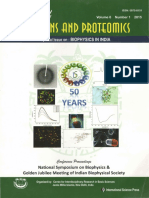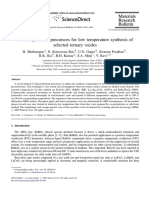0 ratings0% found this document useful (0 votes)
12 viewsStudy of Dynamics of Protein Nanoparticle Complex in Aqueous Medium Using Impedance Spectros
Study of Dynamics of Protein Nanoparticle Complex in Aqueous Medium Using Impedance Spectros
Uploaded by
Muthu RajanCopyright:
© All Rights Reserved
Available Formats
Download as PDF or read online from Scribd
Study of Dynamics of Protein Nanoparticle Complex in Aqueous Medium Using Impedance Spectros
Study of Dynamics of Protein Nanoparticle Complex in Aqueous Medium Using Impedance Spectros
Uploaded by
Muthu Rajan0 ratings0% found this document useful (0 votes)
12 views1 pageOriginal Title
Study of dynamics of Protein Nanoparticle complex in aqueous medium using Impedance Spectroscopy
Copyright
© © All Rights Reserved
Available Formats
PDF or read online from Scribd
Share this document
Did you find this document useful?
Is this content inappropriate?
Copyright:
© All Rights Reserved
Available Formats
Download as PDF or read online from Scribd
Download as pdf
0 ratings0% found this document useful (0 votes)
12 views1 pageStudy of Dynamics of Protein Nanoparticle Complex in Aqueous Medium Using Impedance Spectros
Study of Dynamics of Protein Nanoparticle Complex in Aqueous Medium Using Impedance Spectros
Uploaded by
Muthu RajanCopyright:
© All Rights Reserved
Available Formats
Download as PDF or read online from Scribd
Download as pdf
You are on page 1of 1
JPP40
tendency to acquire helical conformation in helix inducing,
solvent 2,2,2- trifluoroethanol. Overall the increase in
cationic charge of a-MSH improved Staphylocidal
activity and membrane damaging efficacy of the peptides
without compromising their cell selectivity. It also
indicated that electrostatic interactions and ability to
acquire ordered conformation may be crucial for a-MSH_
and its analogues to selectively disrupt microbial
membrane leading to bacterial cell death without
harming host cell membrane.
Structure based Function Prediction of
Hypothetical Proteins from Neisseria gonorrhoeae
oP 21
Kundan Kumar, Amresh Prakash, Asimul Islam, Faizan
‘Ahmad, and Md. Imtaiyaz Hassan’
Centre for Interdisciplinary Research in Basic Sciences
Islamia, New Dethi-110025, India
Jamia Mitta
Neisseria gonorrhoeae is a Gram-negative bacteria
predominantly causes a sexually transmitted infection
known as gonorrhoea. The frequent emergence of new
multiple drug resistant strain need the extensive study
of its genome and development of new drug/ vaccine
against these pathogen. After analysis of the proteome
data of N. gonorrhoeae we found that a large fraction
proteome are listed as conserved hypothetical protein
(HP) for which function are still not known. Study of these
HPs offers presentation of new structures and novel
functions of HPs and also new cascade of biochemical
pathways. Furthermore, new HPs may be serving as
‘markers and pharmacological targets. We have identited
10 HPs showing lyases activity from N. gonorrhoeae from
sequence analysis and performed homology modeling to
reveal the structural basis of the function, structural
motifs and amino acids involved in catalytic sites. Along
with this, function may be inferred on the basis of
properties that are associated with a specie functional
class and family of the proteins. We also studied the sub-
cellular localization and presence of signal peptide in the
HPs, Moreover, sequence analysis was also performed
to find out the physicochemical properties including
‘amino acid composition, aliphatic index and instability
index of HPs. Finally, function annotation and
identidcation of functionally important regions in HPs
from N. gonorrhoeae may leads to better understanding
of its virulence mechanism, adaptability in host system,
tolerance for host immune system and emergence of
drugs resistance strain and finally drug/vaccine
discovery. ~
E-mail: mihassan@jmi.ac.in
Study of dynamics of Protein Nanoparticle
complex in aqueous medium using Impedance
spectroscopy op 22
Mahesh Samant, Bipin Khade, H Muthurajan* P M
Dongre
Department of Biophysics, University of Mumbai, Santacruz (E),
Muni 400098
*National Centre for Nanosciences and Nanotechnology, University
of Mumbai, Mumbai 400098
A rapid development of nanosciences and
nanotechnology offers nanoparticles great applications in
various fields, like drug development, materials for drug
delivery and biosensors etc. Nanoparticles possesses a
unique physicho-chemical properties such as optical,
‘magnetic, large surface to volume ratio etc. Nanoparticles
also confer properties of enhanced bioavailability and
improved solubility. When nanoaprticles enters in
biological fluids, it leads undesired effects. The effects
‘may or may not favour to the systems. Hence itis prime
important to understand interaction between
nanoaprticles and biological materials like proteins,
‘enzymes and nucleic acids etc.
In the present investigation we studied the nanoparticle-
protein complex using dielectric spectroscopy. Dielectric
spectroscopy reveals typical signature of relaxation
process of aqueous media namely dielectric constant,
dielectric loss which commonly known as a, B, y and 8
relaxation.
‘The Chemical route synthesized Silver Nanoparticles
were characterized using Dynamic Light Scattering (DLS),
Transmission Electron Microscope (TEM) and UV visible
spectroscopy. The protein nanoparticles complex was
confirmed by fluorescence and UV visible spectroscopy.
The Frequency dependent Dielectric dispersion of Silver
NP’s and Silver NP-protein complex was investigated in
the temperature range of 263K ~ 373K and in a frequency
range of 20Hz - 2MHz by impedance spectroscopy
(Agilent LCR component analyzer). Variation in dielectric
constant (2’) and dielectric loss (e”) was observed
nanopartilce and protein and Protein-nanoaparticle
complex. Bode plot (impedance vs frequency) showed
increased in impedance (Z) of protein-npts complex.
‘Average relaxation time (x) for a-region (20HZ-100KHZ)
and B-region ( > 200 KHZ) was tabulate in control and
test condition as a function of reciprocal temperature. In
addition, the electrical conductivity was monitored. The
several relaxation processes were attributed to motions
that range from side groups of the proteins in the aqueous
medium,
E-mail: samant.mahesh77@gmail.com
You might also like
- The Subtle Art of Not Giving a F*ck: A Counterintuitive Approach to Living a Good LifeFrom EverandThe Subtle Art of Not Giving a F*ck: A Counterintuitive Approach to Living a Good LifeRating: 4 out of 5 stars4/5 (5940)
- The Gifts of Imperfection: Let Go of Who You Think You're Supposed to Be and Embrace Who You AreFrom EverandThe Gifts of Imperfection: Let Go of Who You Think You're Supposed to Be and Embrace Who You AreRating: 4 out of 5 stars4/5 (1108)
- Never Split the Difference: Negotiating As If Your Life Depended On ItFrom EverandNever Split the Difference: Negotiating As If Your Life Depended On ItRating: 4.5 out of 5 stars4.5/5 (887)
- Hidden Figures: The American Dream and the Untold Story of the Black Women Mathematicians Who Helped Win the Space RaceFrom EverandHidden Figures: The American Dream and the Untold Story of the Black Women Mathematicians Who Helped Win the Space RaceRating: 4 out of 5 stars4/5 (925)
- Grit: The Power of Passion and PerseveranceFrom EverandGrit: The Power of Passion and PerseveranceRating: 4 out of 5 stars4/5 (598)
- Shoe Dog: A Memoir by the Creator of NikeFrom EverandShoe Dog: A Memoir by the Creator of NikeRating: 4.5 out of 5 stars4.5/5 (545)
- The Hard Thing About Hard Things: Building a Business When There Are No Easy AnswersFrom EverandThe Hard Thing About Hard Things: Building a Business When There Are No Easy AnswersRating: 4.5 out of 5 stars4.5/5 (354)
- Elon Musk: Tesla, SpaceX, and the Quest for a Fantastic FutureFrom EverandElon Musk: Tesla, SpaceX, and the Quest for a Fantastic FutureRating: 4.5 out of 5 stars4.5/5 (476)
- Her Body and Other Parties: StoriesFrom EverandHer Body and Other Parties: StoriesRating: 4 out of 5 stars4/5 (831)
- The Emperor of All Maladies: A Biography of CancerFrom EverandThe Emperor of All Maladies: A Biography of CancerRating: 4.5 out of 5 stars4.5/5 (274)
- The World Is Flat 3.0: A Brief History of the Twenty-first CenturyFrom EverandThe World Is Flat 3.0: A Brief History of the Twenty-first CenturyRating: 3.5 out of 5 stars3.5/5 (2272)
- The Yellow House: A Memoir (2019 National Book Award Winner)From EverandThe Yellow House: A Memoir (2019 National Book Award Winner)Rating: 4 out of 5 stars4/5 (99)
- The Little Book of Hygge: Danish Secrets to Happy LivingFrom EverandThe Little Book of Hygge: Danish Secrets to Happy LivingRating: 3.5 out of 5 stars3.5/5 (419)
- Devil in the Grove: Thurgood Marshall, the Groveland Boys, and the Dawn of a New AmericaFrom EverandDevil in the Grove: Thurgood Marshall, the Groveland Boys, and the Dawn of a New AmericaRating: 4.5 out of 5 stars4.5/5 (270)
- The Sympathizer: A Novel (Pulitzer Prize for Fiction)From EverandThe Sympathizer: A Novel (Pulitzer Prize for Fiction)Rating: 4.5 out of 5 stars4.5/5 (122)
- Team of Rivals: The Political Genius of Abraham LincolnFrom EverandTeam of Rivals: The Political Genius of Abraham LincolnRating: 4.5 out of 5 stars4.5/5 (235)
- A Heartbreaking Work Of Staggering Genius: A Memoir Based on a True StoryFrom EverandA Heartbreaking Work Of Staggering Genius: A Memoir Based on a True StoryRating: 3.5 out of 5 stars3.5/5 (232)
- On Fire: The (Burning) Case for a Green New DealFrom EverandOn Fire: The (Burning) Case for a Green New DealRating: 4 out of 5 stars4/5 (75)
- The Unwinding: An Inner History of the New AmericaFrom EverandThe Unwinding: An Inner History of the New AmericaRating: 4 out of 5 stars4/5 (45)
- 06 Chapter 2Document10 pages06 Chapter 2Muthu RajanNo ratings yet
- Protein ImpedanceDocument2 pagesProtein ImpedanceMuthu RajanNo ratings yet
- JHM - He Article in PressDocument4 pagesJHM - He Article in PressMuthu RajanNo ratings yet
- Low Temperature Synthesis of SrNb2O6 and SrTa2O6 Using Hydroxide PrecursorDocument3 pagesLow Temperature Synthesis of SrNb2O6 and SrTa2O6 Using Hydroxide PrecursorMuthu RajanNo ratings yet
- Novel Hydroxide Precursors To Prepare NaNbO3 and KNbO3Document3 pagesNovel Hydroxide Precursors To Prepare NaNbO3 and KNbO3Muthu RajanNo ratings yet
- Novel Hydroxide Precursors For Low Temperature Synthesis of Selected Ternary OxidesDocument8 pagesNovel Hydroxide Precursors For Low Temperature Synthesis of Selected Ternary OxidesMuthu RajanNo ratings yet
- Arduino Ethernet ShieldDocument68 pagesArduino Ethernet ShieldMuthu RajanNo ratings yet















































